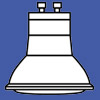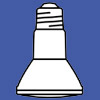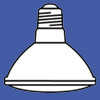Lampholder Designs
Lux is a measure of illumination on a surface (lumens per square metre) and the values given in the diagrams show the peak intensity at the beam centre at distances of 1, 2, 3 and 4 metres from the lamp.
The beams are drawn at the end angle where the intensity is 50% of the intensity at the centre. The lux values in the diagrams are reproduced from lamp manufacturers' data.
Lamp Selection Data
Click Picture for Beam Angles and Lux Levels.
Source: iLLUMA Lighting




